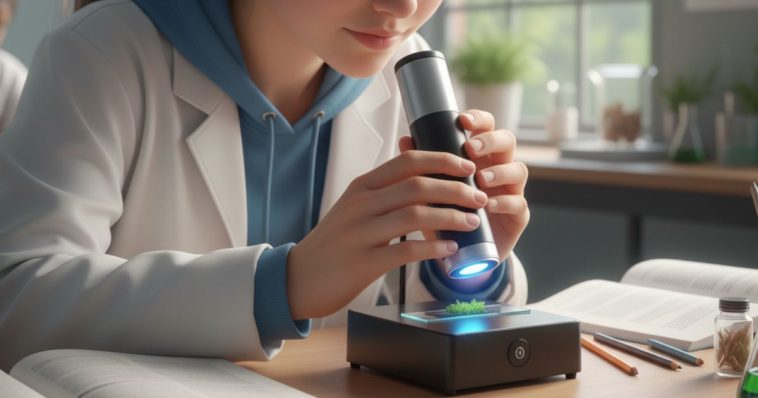Exploration knows no limits, and pocket microscopes make observing the microscopic world easier than ever. Compact yet powerful, these devices reveal the intricate details of plants, insects, and materials, turning everyday objects into fascinating subjects for study. Their portability and advanced features make them ideal for a wide range of users, from students learning science to hobbyists exploring nature and professionals conducting fieldwork.
Small enough to carry anywhere, pocket microscopes bring hands-on learning and discovery to any environment. With high magnification, adjustable lighting, and even smartphone connectivity on many models, they combine convenience with capability, making scientific observation accessible, interactive, and engaging for users of all ages and skill levels.
What Is a Pocket Microscope?
A pocket microscope is a small, portable microscope engineered for easy, on-the-go observation. Unlike traditional laboratory microscopes, typically bulky and stationary, pocket microscopes are lightweight and handheld, making them ideal for fieldwork, classroom experiments, or casual scientific exploration. Despite their compact size, these microscopes offer impressive magnification ranges—from 20x to 1000x or more, depending on the model—enabling the detailed study of samples such as plant cells, minerals, textiles, or insects.
Modern pocket microscopes often feature LED lighting, providing bright and consistent illumination for clear viewing in any environment. Adjustable focus mechanisms enable precise observation at varying depths, while smartphone connectivity allows for capturing, sharing, and analyzing images instantly. These features make pocket microscopes practical for scientific study and versatile tools for education, hobbies, and even professional fieldwork. Their portability and technological enhancements transform microscopy into an accessible, flexible, interactive experience.
Key Features to Consider
Magnification Power
Pocket microscopes offer a wide range of magnification levels, typically ranging from 20x to 1000x, catering to various observation needs. Lower magnification settings are suitable for educational purposes or casual hobbyists, allowing users to examine leaves, insects, coins, and other small everyday objects clearly. Higher magnification is ideal for scientific study or detailed research, enabling the examination of cells, microorganisms, or fine textures that require precise observation and analysis. Adjustable magnification ensures versatility, allowing a single device to serve multiple purposes across education, hobbies, and professional use.
Illumination
Many pocket microscopes feature built-in LED lighting, which significantly enhances visibility and allows for precise observation of small or transparent objects, even in low-light environments. Some models offer adjustable brightness, allowing users to control the lighting intensity to suit different samples or magnification levels. Proper illumination ensures sharp contrast, improved detail, and accurate color representation, which are crucial for scientific work, hobby projects, or field research. This combination of built-in light and adjustable brightness transforms a compact microscope into a powerful tool capable of high-quality observation anywhere.
Portability & Design
Pocket microscopes are engineered for maximum portability and durability, making them ideal for use in classrooms, laboratories, outdoor fieldwork, or on-the-go exploration. Their lightweight and compact design allows them to fit comfortably in backpacks, lab kits, or even a pocket, while rugged construction ensures they can withstand everyday handling. Some models feature foldable or retractable designs, providing extra protection during travel and reducing the risk of damage, making them highly convenient for students, hobbyists, and professionals.
Connectivity & Imaging
Modern pocket microscopes often feature smartphone or computer connectivity, allowing for high-resolution image and video capture. This will enable users to store, share, and analyze discoveries digitally, making it easier to document experiments, create educational content, or collaborate with peers remotely. For educators, students, and field researchers, this connectivity transforms the microscope from a simple observation tool into a versatile digital platform that supports interactive learning and professional research.
Ease of Use
A quality pocket microscope emphasizes user-friendly operation. Features such as simple focus adjustment, ergonomic grips, and sturdy construction ensure that users of all ages and skill levels can easily explore their surroundings. Clear markings, intuitive controls, and stable bases enhance the experience, allowing beginners and seasoned users to examine samples with precision and comfort. This combination of accessibility, durability, and functionality makes pocket microscopes an excellent choice for educational, recreational, and professional applications.
Advantages of Pocket Microscopes
Portability
Pocket microscopes are designed for effortless portability, allowing close-up observation virtually anywhere. Their compact and lightweight construction eliminates bulky laboratory equipment, making them ideal for carrying to classrooms, science clubs, nature trails, or field research sites. This portability ensures that detailed examinations can occur on the spot, whether studying plant cells in the field, inspecting work materials, or exploring everyday objects at home.
Hands-On Learning
Pocket microscopes provide an immersive, hands-on learning experience that brings science to life. They spark curiosity and engagement by enabling real-time observation, encouraging learners to explore and investigate independently. Students, hobbyists, and educators can study biological structures, mineral compositions, or mechanical details in a tangible, interactive way, making complex concepts easier to grasp. This approach reinforces theoretical knowledge and fosters critical thinking and observational skills, turning abstract lessons into memorable, practical experiences.
Professional Applications
Beyond educational use, pocket microscopes are efficient tools for professional fields requiring precision and portability. Field scientists can examine specimens in remote or challenging environments, jewelers can evaluate gemstones with detailed scrutiny, watchmakers can inspect intricate movements, and electronics technicians can analyze circuits or components up close. Their versatility, compact design, and reliable magnification make them indispensable across various professions, providing a convenient way to perform detailed inspections and analyses wherever high precision is required.
Cost-Effective Exploration
Pocket microscopes offer an affordable gateway into the world of microscopy, providing capabilities similar to those of traditional lab microscopes without the high price tag. Their compact, all-in-one design eliminates the need for additional equipment, making them accessible for students, hobbyists, and educators. This cost-effectiveness allows for hands-on exploration and learning without significant investment, opening up opportunities for experimentation, observation, and discovery in classrooms, at home, or in the field.
Interactive & Shareable
Many modern pocket microscopes feature smartphone or computer connectivity, allowing users to capture, document, and share observations in real-time. This functionality enhances the learning and research experience by allowing images and videos to be stored digitally, shared with peers or instructors, and analyzed collaboratively. The ability to create interactive, shareable content transforms microscopy from a solitary activity into an engaging, social, and educational experience, making discoveries accessible to a broader audience.
Trends in 2025
The pocket microscope market continues to innovate, offering features that expand its usability:
Smartphone Integration
Many modern pocket microscopes feature built-in camera systems, allowing for the instant capture and analysis of specimens. This enables users to photograph or record their high-resolution observations, making it easy to document findings for study, presentations, or hobby projects. Smartphone integration also supports real-time viewing and measurement, providing a portable lab-like experience that enhances learning and research efficiency.
Wireless Connectivity
Advanced pocket microscopes often feature Bluetooth or Wi-Fi connectivity, allowing live streaming of magnified images directly to mobile devices, tablets, or computers. This seamless connection enables collaborative study, remote instruction, or interactive presentations, making microscopy more accessible and engaging. Wireless functionality also facilitates easy storage, sharing, and annotation of images, turning the pocket microscope into a versatile tool for education, field research, and professional applications.
Adjustable LED Lighting
Many pocket microscopes feature adjustable LED lighting to optimize visibility across different sample types and lighting conditions. Multiple brightness levels allow for precise illumination of transparent, opaque, or low-contrast specimens. Some models also feature color-adjustable LEDs, enhancing detail and contrast for specific applications. This flexibility ensures that every sample can be observed clearly in a brightly lit classroom, a dim field environment, or during close examination of intricate materials.
Compact and Durable Designs
Pocket microscopes are engineered with compact, rugged designs that withstand the rigors of everyday use and outdoor exploration. Many models use water- and dust-resistant materials, ensuring reliable performance even in challenging environments such as rain-soaked trails, dusty field sites, or sandy beaches. This durability allows users to carry microscopes confidently anywhere, from classrooms to nature trips, without worrying about damage, making them highly practical for educational and professional applications.
Educational Kits
Many pocket microscopes are now sold as part of comprehensive educational kits, making them ideal for students, teachers, and hobbyists looking to explore the microscopic world. These kits often include prepared slides featuring plant, animal, or mineral samples, as well as blank slides for creating custom specimens. Additional accessories such as tweezers, droppers, and magnification guides enhance hands-on learning and experimentation.
Some kits also integrate digital learning tools, including apps or software that provide interactive lessons, tutorials, and the ability to annotate or analyze captured images. By combining a pocket microscope with these educational resources, users gain a comprehensive and engaging learning experience that fosters curiosity, develops observational skills, and encourages scientific exploration.
Small Device, Big Discovery
Pocket microscopes demonstrate that powerful tools don’t have to be large. They make scientific exploration and discovery accessible to everyone—from students and hobbyists to professionals in the field. Whether examining plant structures, inspecting tiny electronics, or exploring the hidden microcosm of nature, a pocket microscope brings intricate details into clear view, all within the palm of your hand.
In 2025, pocket microscopes will combine portability, convenience, and increasing power, allowing observation and analysis anywhere, anytime. Compact yet versatile, they will transform the way science is experienced, offering a hands-on approach to learning, research, and exploration without the need for a traditional lab setup. These small devices will make uncovering the unseen details of life both practical and exciting.



